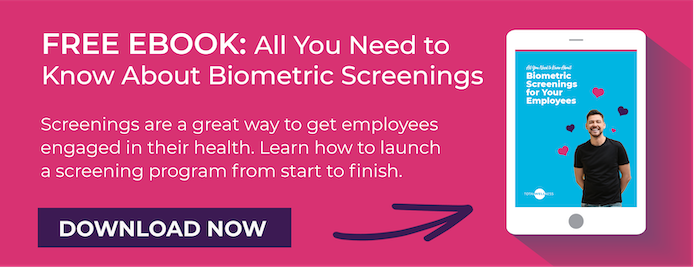 Imagine this: a hassle-free, time-efficient health checkup that takes place right where your employees spend most of their day.
Imagine this: a hassle-free, time-efficient health checkup that takes place right where your employees spend most of their day.
That's the beauty of an on-site biometric screening.
It's a powerful tool that unveils your employees' baseline health scores, paving the way for a future of informed decisions and proactive wellness.
But even with all the valuable insights screenings provide, we know you still want to ensure you're getting the biggest bang for your buck.
That's why we've gathered a list to help you optimize your biometric screening experience and get the most out of your investment. Whether you're a seasoned HR guru or a newbie to the game, we've got insider tips and expert advice that will have you feeling like a wellness pro in no time.
So, let's dive into the nitty-gritty details of biometric screening programs.
Maximizing Biometric Screenings
Plan Ahead and Communicate
Before conducting on-site biometric screenings, establish clear goals and objectives for your program. Determine what health metrics you want to measure and track, such as cholesterol levels, blood pressure, body mass index (BMI), or glucose levels. Communicate the purpose and benefits of the screenings to employees well in advance to ensure their participation and alleviate any concerns.
Choose a Trusted Provider
Partner with a reputable wellness company, like TotalWellness, that specializes in on-site biometric screenings. Look for experienced professionals who can handle the logistics, perform accurate screenings, and offer secure data management. Ensure they follow industry standards and comply with privacy regulations, such as HIPAA, to protect employee information. References and testimonials? Don't be shy, ask for them!
Provide Convenient Scheduling
Offer flexible scheduling options to maximize employee participation. Consider providing multiple screening dates, times, and locations to accommodate various shifts or remote workers. Allow employees to sign up in advance to secure their preferred time slots, reducing waiting times and ensuring a smooth screening process.
Promote Privacy and Confidentiality
Creating a safe and secure environment for employees to share their health information is crucial. Assure them that their data will be securely stored and comply with all relevant privacy laws. Their trust is a precious gem, so handle it with care.
Educate and Empower Employees
Offer pre-screening educational materials to help employees understand the purpose and importance of the screenings. Provide resources that explain the significance of the measured health metrics and how they relate to overall well-being. Encourage employees to take action based on their results, whether it's seeking further medical advice or making lifestyle changes. They are the heroes of their own wellness journeys—empower them.
Follow-Up and Support
Don't let the screening process be a standalone event. Offer post-screening resources and support to employees. This can include providing personalized feedback on results, connecting individuals with relevant wellness program resources, or offering coaching services. Encourage ongoing engagement and regular follow-up screenings to track progress and maintain a focus on long-term health goals.
Foster a Culture of Wellness
Integrate these biometric screenings into a holistic wellness program. Think flu shot campaigns, fitness challenges, mental health support, and enlightening educational initiatives. Show your employees that their well-being is not just a priority but a cornerstone of your company's DNA.
From Data to Action
Now, onto the exciting part: the data.
After hosting a successful biometric screening event for your employees, you'll find yourself armed with a treasure trove of valuable health data. But what should you do with this wealth of information?
Transform numbers into action! Here's how to make the most of the data gathered during your biometric screenings.
- Analyze and Identify Trends: Dive into the collected data and identify patterns or trends that emerge. Look for common health risks, prevalent conditions, or areas where employees may need additional support. By analyzing the data, you can gain valuable insights into the overall health of your workforce and identify opportunities for targeted wellness initiatives.
- Communicate Results: Transparency is key when it comes to sharing the results of the biometric screenings with your employees. Consider organizing informational sessions or workshops where you communicate the overall findings, provide resources for addressing specific health concerns, and offer guidance on how employees can make positive lifestyle changes.
- Personalize Wellness Programs: Use the data gathered from the biometric screenings to tailor your wellness programs and initiatives to the specific needs of your employees. Whether it's implementing targeted challenges, offering nutritional workshops, or providing resources for stress management, personalized approaches are more likely to resonate with employees and drive engagement.
- Evaluate Program Effectiveness: Continuously monitor and evaluate the effectiveness of your wellness programs based on the biometric screening data. Track changes in employee health metrics over time and assess the impact of interventions or initiatives you have implemented. This will help you refine your approach and ensure that your wellness programs are delivering meaningful results.
Related: Checkout our 2022 Biometric Screening Aggregate Results
On-site biometric screenings are a powerful tool for employers to proactively support employee wellness. By implementing these best practices, you can create a successful screening program that promotes a culture of health, empowers employees to make positive lifestyle changes, and ultimately leads to a happier, healthier, and more engaged workforce.
How does your company implement biometric screenings in the workplace? Share your comments and thoughts down below!



